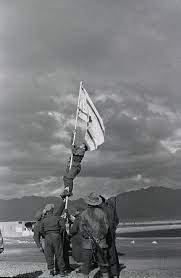SAVIOURS IN THE SKY - AIRMEN IX
From the early hours, on the Sabbath of January
8th, pilots were already strapped in their cockpits. They were
waiting for the inevitable reprisal attack from the humiliated RAF. The hours
crept by as the tension mounted.
Contrary to the demands of the RAF squadron leaders who were
begging for the go-ahead to launch a massive retaliatory strike against Israel,
RAF headquarters withheld permission. Instead,
the British Foreign Office fired off a furious protest to the Israeli
government, demanding compensation for the loss of airmen and aircraft.
Truman was condemning the
British for interfering in the Middle East conflict. The British House of
Commons was in an uproar. While they were debating the issue, Winston Churchill
demanded an explanation for the unreported downing of another British
warplane shot down over the coast of Israel the month before! Although the British Air Ministry tried to dodge the
question, Churchill continued to probe. When finally admitting that the
warplane had been on a reconnaissance mission over Israel, the truth came to
light. The British squadron based in Cyprus had been regularly flying such
missions since the beginning of hostilities.
The overall tally of British aircraft shot down by the IAF had
risen to six.
An Egyptian brigade had been cut off and starving inside the Faluja
Pocket. Egypt was on the brink of revolution at the huge loss of life and
resources which they had suffered. As a condition of the truce, all Israeli
forces were to withdraw from Egyptian territory by January 10th.
Two days later, the delegations of Israel and Egypt began
UN-sponsored peace talks. Israel, which had paid the overwhelming price of over
six thousand deaths, was more than ready for the end of a war which was not of
their choosing.
An armistice agreement was signed in Rhodes on 29th
February. The other Arab countries followed Egypt’s example, except for Iraq
which, however, agreed to cease hostilities.
There still remained an unresolved dispute. The 120 miles of desert
extending from Beersheva to the port of Eilat. It was a vital gateway to Africa
and the Far East, and was still unclaimed. Since the end of the fighting,
Jordan had been quietly infiltrating troops into the southern desert.
Israel was determined to establish its claim on the vast wasteland of the Negev. It had always been Ben-Gurion’s dream of a home for future immigrants. The two IDF units taking part in Israel’s last offensive, were given orders to avoid conflict with the Jordanians on the east, and the Egyptians along the western border.
Another landing strip, called Hatzor, had been hastily carved out in the wilderness - 30 miles from Eilat.The transport planes began hauling reinforcements, ammunition and food
for the fast-moving Israeli brigades in round-the-clock missions.
Five days after the Operation had begun, on March 10th,
vehicles of the Negev Brigade, covered with dust and filled with cheering
Israeli soldiers, rolled into the ancient port of Eilat. They met no
resistance. The Transjordan occupying troops had already gone home. One of the
nurses from an ambulance unit appeared with a bedsheet, on which they painted
an Israeli flag. A young captain slithered up a makeshift flagpole to mount
what would be called the “Ink Flag”.
The two brigades, the Negev and Golani, had achieved one of
Israel’s most significant victories - without a fight. Israel had doubled its
land mass. The raising of the “Ink Flag” marked a symbolic end to Israel’s War
of Independence.



Comments
Post a Comment